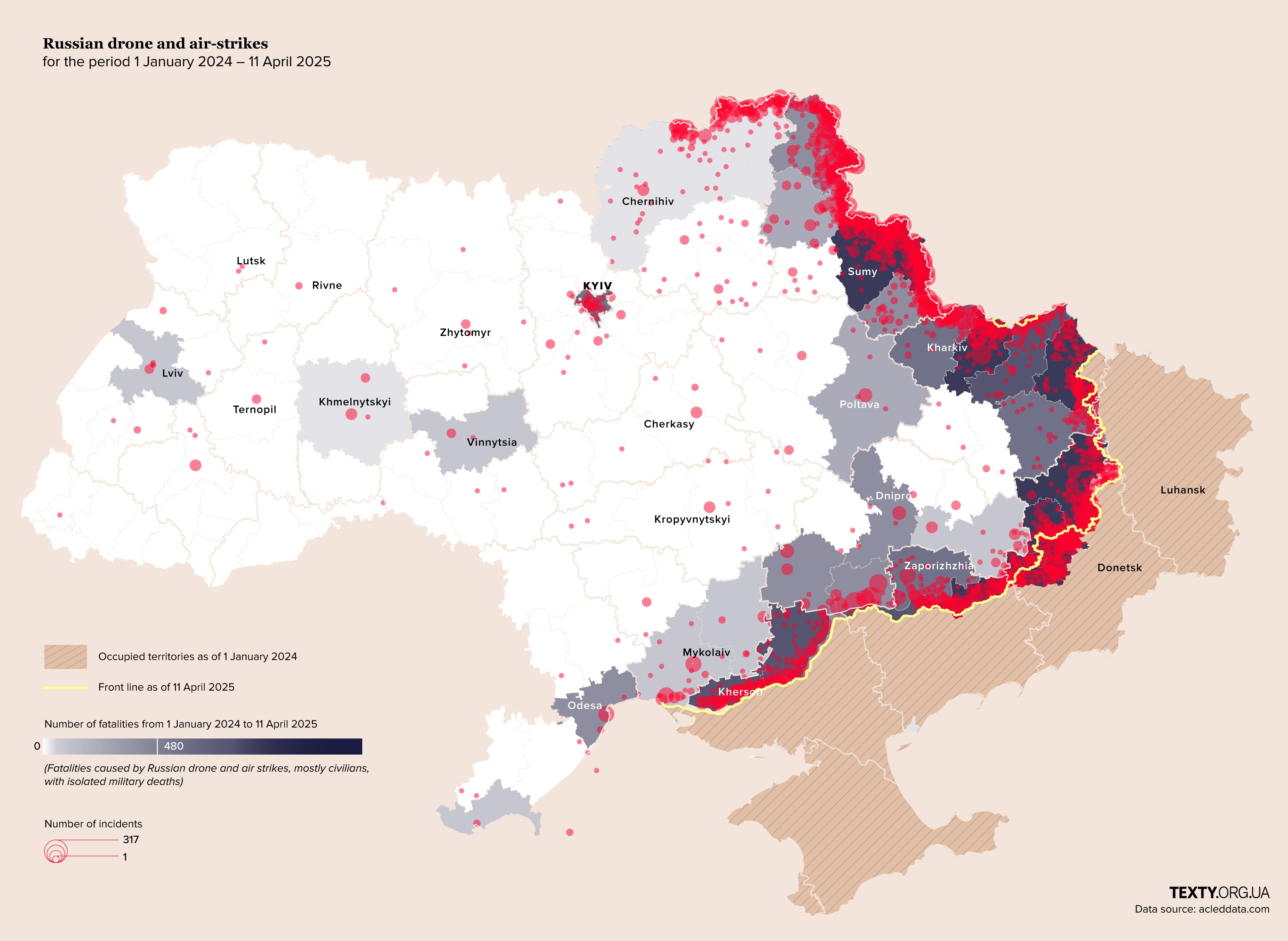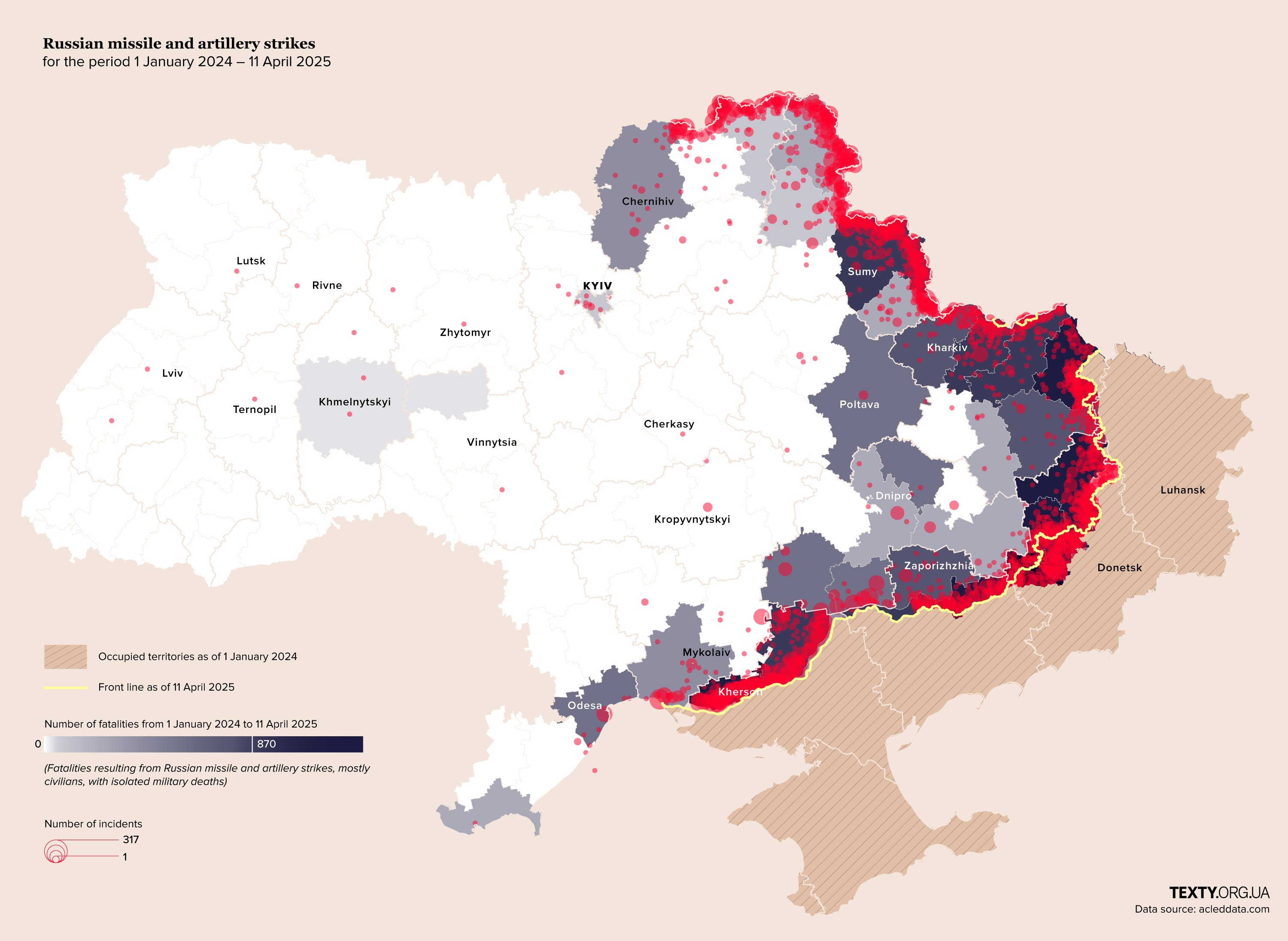The conveyor of destruction. How Russia is targeting civilians with drones and missiles (MAP)
The traditional Russian occupation strategy involves terrorizing civilians so that the majority no longer has the strength to endure and decides to stop resisting. In this case, military defeat is only a matter of time. That is why the Iranian drones Shaheds and missiles are flying towards peaceful cities to terrorize civilians, including children and older people.
Texty.org.ua investigated, which cities in Ukraine are most affected by these attacks.
The conveyor of destruction
Not only are military targets being shelled and destroyed, but literally everything that is vital to people — energy facilities, hospitals, schools, kindergartens, industrial and agricultural enterprises, and transport infrastructure, including public transport. Even stables and barns are being hit.
However, the worst thing is that this is an endless conveyor belt of human deaths. Every day, we have civilian casualties from Russian strikes, sometimes hundreds of kilometers from the frontline

The areas directly bordering the line of contact are the first to be shelled: Donetsk, Kharkiv, Sumy, and Zaporizhzhia. However, the Russians' massive strikes are not limited to these areas. The Chernihiv region, which borders Russia, is also subject to systematic attacks.
Drones and missiles regularly strike regions that do not share a border with Russia and are not or practically not located on the line of contact, such as Odesa and Mykolaiv. The Ukrainian capital, Kyiv, is also subject to massive attacks.
Moscow systematically reaches places deep inside Ukrainian territory, such as Khmelnytskyi, where there are several military airfields, and Lviv in the West of Ukraine, where strikes on gas storage facilities have become yet another episode in the destruction of infrastructure necessary for life support.
Of course, the Russians present all this as attempts to destroy Ukrainian military facilities. On their propaganda resources, they claim that all the schools they destroyed were used as military bases and that civilian homes were used as deployment points and headquarters for the Armed Forces of Ukraine.
However, the number of civilian casualties indicates that the primary targets of the strikes are civilian infrastructure and the population. In addition, there are many military personnel in Ukraine, and there may be a soldier on leave on every street where a missile has struck. This does not negate the fact that the targets were likely civilians.
Let's recall the tactics used by the Russians in Syria. They bombed densely populated cities with the maximum number of casualties, separately "hunting" hospitals, deliberately dropping bombs and launching missiles at them. As a result, a significant number of people left the regions under attack, which made it easier for Assad's troops to advance on the ground. And the Russians disguised all this as a war against "Islamists" — as if they were striking their camps.
Since then, their set of tools for implementing scorched earth tactics has only expanded.

At the beginning of the war, the Russians tried to use aviation in Ukraine, as they did in Syria (read here about how Russian aviation tried to bomb civilian targets in Chernihiv). Still, our air defense and military aviation stopped them.
Today, drones, primarily the notorious Shaheds, are used for destruction in the rear. If we look at the map, we can see that the Russians are using them to strike not only industrial centers but also much smaller targets.
This began after Russia increased its capacity to produce Iranian "Shaheds."
This is evidenced by the red dots indicating shelling. The map shows that although the whole of Ukraine is under attack, the regions adjacent to the front line are suffering more than those further west. And this began after Russia increased its capacity to produce Iranian Shaheds.
For example, in the first year of the war, the front line was closer to the Poltava region than it is now, but it was not shelled as intensively. Air strikes were also added in the areas directly adjacent to the front line.
Rockets are more deadly

On this map, we can see how the regions that have been hit by rocket attacks are getting "darker" in terms of the number of victims. We're talking mainly about the Chernihiv, Poltava, Dnipro, Kharkiv, and Odesa regions. Most of these regions are not directly on the front line but Russian missiles have reached them. In addition, enemy artillery continues its destructive work along the entire current Ukrainian perimeter
Mines and terror
It is logical that large minefields are located on the front line. However, they also remain in liberated territory. An invisible death lurks for anyone who carelessly steps on them.

To this should be added attempts by Russians to organize terrorist attacks in the Ukrainian rear, primarily using homemade explosive devices (read more about this here).

